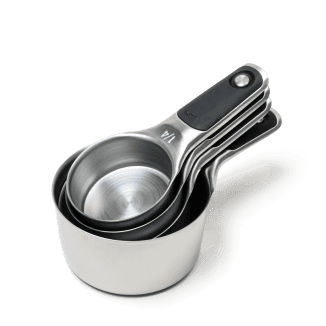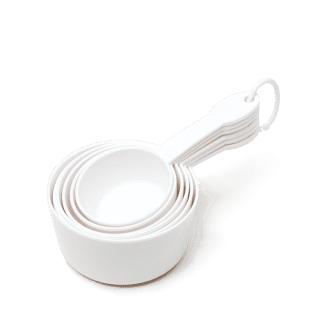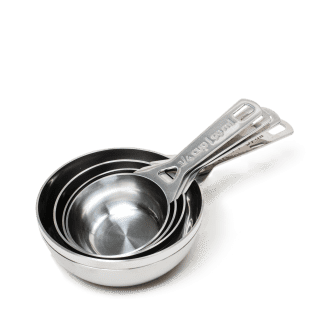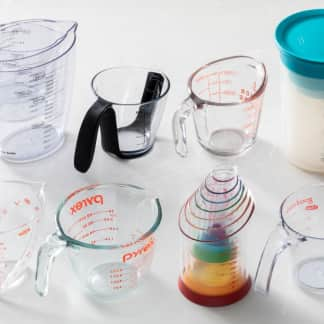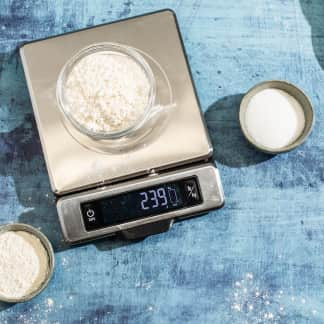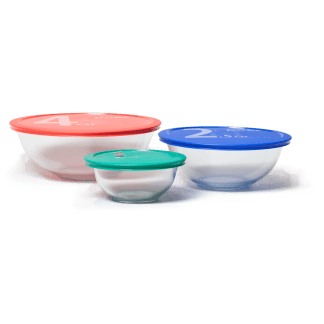Success in baking starts with careful measuring. And while a good scale is the most accurate tool, dry measuring cups are often more practical for the home cook. Lots of new models have come on the market since we last tested measuring cups eight years ago, so we decided to revisit the category. We rounded up 12 sets, including our prior winner (from Amco), and headed into the test kitchen to see which ones measured up.
Our preferred measuring method for dry ingredients is the “dip and sweep”: We dip the cup into the container of flour or sugar, scoop out a heaping cupful, and then sweep the top of the measure level with the back of a knife. Models with handles that extend out on the same plane as the top of the cup best accommodate this, so we chose a combination of metal and plastic cups with this basic shape. We also limited our selection to sets that included at least the four essential sizes: 1 cup, 1/2 cup, 1/3 cup, and 1/4 cup.
First we evaluated the cups for their most important quality: accuracy. We carefully filled each cup to its maximum capacity with both water and granulated sugar and weighed it on a calibrated lab-quality scale; then, knowing how much a cup of both water and sugar should weigh, we did the math to determine accuracy and scored the cups accordingly. Three sets were off by as much as 6 percent, sending them tumbling in the rankings. Our top performers were either spot-on or off by just a fraction of a percentage point.
Next we turned to ease of use. We asked a range of test cooks and editors to dip and sweep a cup of flour with the 1-cup measure from each of the 12 sets. Even with our carefully vetted lineup of straight-handled cups, our testers found problems with several models—those with rims slightly higher than the handles created a jarring catch to the sweeping motion that was at best awkward and at worst jostled the cup and required us to start anew. We preferred cups that were perfectly even with the handles for seamless sweeping.
The measurement markings on some cup sets were large and well placed on the handles, where they were easily identifiable. Cups with tiny or hidden markings were irksome, as we had to double-check to see which cup we were using. The downfall for some plastic cups was the impermanence of their measurement markings; those that were printed in ink came off with very little scrubbing. Almost all the stainless-steel sets have markings that are etched on; no amount of scrubbing was going to take those off. One outlying stainless-steel set had markings in ink on plastic handles—markings that came right off.
An additional problem: When we filled cups with flour and placed them on the counter, some smaller ones with long handles tipped over and spilled, causing them to lose points.
To test their durability, we used the cups to repeatedly scoop up wet, heavy sand to simulate years of hard use. Most plastic cups flexed with the motion and went right back into place, although a few smaller cups bent permanently. Many of the stainless-steel handles bent when we used great force; others bent immediately, with very gentle scooping. The most durable sets, including the winner, have shorter handles that are part of the cup mold (rather than riveted on) and didn’t bend or flex at all.
Our winning measuring cups, from OXO, are made of sturdy, durable stainless steel and are accurate and easy to use. They have handles perfectly flush with the cup rims for seamless dipping-and-sweeping and laser-etched markings that don’t scrub off; plus, they have the handy bonus feature of magnetic tabs to keep the stacked cups tidy in a drawer or cabinet (their short handles also make them more compact and easy to store). These cups are an intelligent improvement on the classic design.
The Tests:
- Fill with granulated sugar, weigh, and compute to determine accuracy
- Fill with water, weigh, and compute to determine accuracy
- Dip and sweep flour
- Dip and sweep wet sand
- Run through dishwasher 10 times
- Aggressively scrub printed markings with scouring pad
- Set empty cups on counter to gauge stability
- Set cups filled with flour on counter to gauge stability
How We Rated:
- Accuracy: We tested the accuracy of each cup by carefully filling each one with both water and sugar, weighing it on our lab-quality scale, and calculating the variance from the accepted weight for each volume of both materials. Less-accurate cups scored lower.
- Durability: We used the cups to scoop up heavy wet sand and noted any bending or flexing of their handles; ran all the cups through a home dishwasher 10 times to note warping or measurement-mark wearing; and scrubbed the cups with an abrasive scouring pad to test the permanence of measurement markings.
- Ease of Use: A group of male and female test cooks and editors with varying hand sizes dipped the cups in flour and swept off the extra with the back of a butter knife. Those they found easiest to use were ranked highest; those that felt uncomfortable or unwieldy were downgraded. We noted how stable each cup was when placed on the counter both empty and filled with flour; those that tipped over lost points.
- Accurate measurements
- Easy-to-read measurement markings
- Durable measurement markings
- Stable when empty and when filled
- Strong and durable design
- Handles perfectly flush with cups
- Stacked and stored neatly

